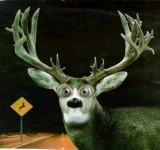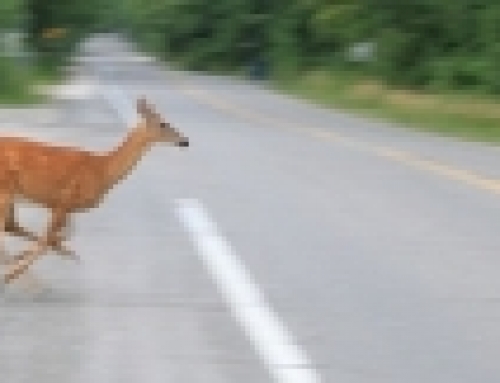Close Encounters
of the
Nature Kind

By
Dennis P. (Wombat) Dougherty
Senior Road Captain
It’s that time of year again. Winter is officially over, Spring has sprung and a young (and old) person’s fancy turns to thoughts of love… of all things motorcyclin’.
As we pull the cover off our iron steeds, unhook our trickle chargers, run the StaBil treated gas out of the tank and knock the dust off our rides, we need to be thinking about lots of things as we gear up for another fun and adventurous riding season. I’ll let others write about the mental preparation and polishing up on our own riding skills. I want to focus this article on the other entities that share our riding environment that are either waking hungry from a winter’s slumber or who also have thoughts of fancy with their own species…namely the critters.
Now critters come in all shapes and sizes, from a lowly bushy-tailed nut-hauling rodent, to a nauseously perfumed polecat, on up to a white-tailed leaper and more. This time of year both Homo-Motorcyclus, and Critter-MostAnoyingus are still clearing the cobwebs from the winter doldrums. Neither of us are at the top of our game. It is a particularly dangerous time of year for both of us as we venture out of our winter habitat and too often find ourselves sharing some piece of road.
Fundamentally, man paved roads to facilitate travel for our motorized vehicles. Not as sightseeing venues or warming beds for Mother Nature’s wild inhabitants. We as disciplined riders usually stick to the asphalt unless on a vehicle specifically designed not to. Mother Nature never designed anything to use our paved pathways. But none-the-less, and far too often, there are furry (and not so furry) interlopers that sneak into our domain and cause unexpected encounters. Most of the time the interactions are relatively harmless and non-threatening, but sometimes they can be quite sudden and dangerous. As safe riders, we need to be prepared for them.
So what do you do when something big like Bambi and her family decide to stare you down in the middle of the road, or worse yet, dart out of the bushes from the side of the road in a full sprint in front of you? Unless you have a clear and easy path around them, don’t try to swerve around them. It is a natural, instinctive thing to try to do, but in reality you could be putting yourself and your bike in more danger. You are already in a near panic state. Swerving around them basically puts you in a turn with less traction and less control. And besides, you don’t know what the animal is going to do. It might turn and go in the direction of your swerve further exacerbating your escape maneuver. The situation can quickly disintegrate into something much worse. It’s easy to lose total control and find that you’re just a passenger hanging on for dear life on a 900 pound out-of-control runaway mass of chrome, steel, plastic, and rubber looking for something hard and solid to finally stop you and it. The resulting twisted wreckage can always be replaced. Your parts, on the other hand, are not nearly as interchangeable.
So what should you do when you find a deer or other large animal all of a sudden standing in front of you on the road? You should treat them exactly the same as a big rock or tree that you suddenly find in the middle of the road. Generally the best and safest maneuver is to execute maximum performance braking…straightening up the bike and applying full force on both brakes and try to stop before you hit it. Quite often the animal will take off away from your line of travel, so you’ll end up in the clear. Once again, swerving could make it worse. However, that tale of ‘deer in the headlights’ is all too true. Some may not move, and if you’re on a collision course with one that doesn’t, you may have to brace for impact. But at least you will be making contact with maximum control of your bike. Depending on the size of the animal, with your momentum, chances are, some energy will be translated into moving the animal… at least a little. But it will still be a sudden stop and it probably won’t be pretty. That’s why maximum braking is so important.
If you hit a deer (or other large animal) head on, there is a reasonable chance it will flip up over your handlebars and head. When that happens, if possible, initiate maximum performance braking beforehand, bow your (and your passenger’s) head down to keep them out of the path of travel of the airborne carcass and keep the bike vertical and on a straight path. Chances are pretty good the bike will go down, but at least you will be going straight and can maintain some control over the direction of travel. You have already started to slow the bike down with your maximum performance braking action which should help lessen the resulting carnage.
If a deer decides they want to jump over you and your bike and somehow lands on your fender or in your lap, about the only thing you can do is hold on and try to keep the bike upright and stay on the asphalt if at all possible. Pilots have an old saying, “When in an emergency situation, Always fly the airplane first!” The same holds true when riding. Do everything you can to maintain maximum control of your bike, no matter what is happening to you and it at the time.
Now I don’t want to offend the tree-huggin’ PETA apostles, but when facing a standoff with the small (usually) furry stuff (5 lbs. or less) or one crosses your path of travel, your best bet is to ride right over them. As with big animals, swerve only if you have a clear path of travel to an exit point and beyond. Yeah, you may feel a thump and afterwards you may need to find the nearest wand wash to remove some newly acquired unwanted crimson entrails decorating your undercarriage. But once again, maintain maximum control of your bike at all times, even if it means riding through the obstacle. Remember to exercise proper obstacle clearance technique when impacting the critter: come up off your seat and apply a bit of throttle to lighten the front end load as you impact the obstacle. Roll off the throttle once the front tire has cleared it. Brake when safely on the other side if necessary.
There is no doubt that the best way to avoid these unwanted nature encounters is through constant situational awareness and vigilance when riding. Animals love to feed and are usually very active two hours before and two hours after sunrise and sunset. Slow down during those times and do the Bobblehead Mambo…. keep your head and eyes up and moving from side-to-side at all times searching for something unusual on the road, or just off of it, that might compromise your path of travel. Slow down at night, particularly in areas where you know deer and other wildlife are active.
Finally, practice, practice, practice! Head out to a parking lot and practice maximum performance braking, brake and evade tactics, clearing small obstacles, and quick swerves. They should be second nature to you. You don’t want to have to think about how to do them when you need them. When practicing maximum performance braking, be particularly aware of using proper braking technique to avoid a ‘high side’ accident. Remember, if you lock the front wheel, release it immediately, otherwise you lose directional control. If you lock the rear wheel keep it locked until you stop. Otherwise you risk the likelihood of an ugly high side accident. We all get rusty. Consider taking an advanced rider course, or even a basic rider course as a refresher.
One of the best things about riding is being close to nature and seeing it in all its glory… from a distance. When a close encounter with an unwanted road guest occurs, know the proper technique for dealing with it so you both can enjoy each other another day.
Ride Safe!
-Wombat-





